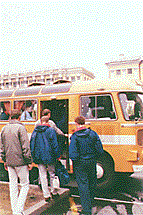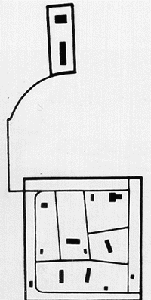| The
logistics of scheduling, transporting, housing, feeding,
equipping, and supporting this and other INF inspection
teams and the aircrews was a major effort for both the
U.S. and the Soviet on-site inspection agencies. Both
nations needed an extensive logistical infrastructure.
OSIA established field offices and support personnel in
Washington and San Francisco; at Yokota Air Base in
Japan; at Frankfurt, West Germany; and in Moscow and
Ulan-Ude in the Soviet Union. Stretching across 19 time
zones, these people and offices had responsibility for
supporting the mission of on-site inspections and escorts
under the INF Treaty.25 Colonel Troyan's team was not the only American inspection team in the USSR during September and October 1988. Three other U.S. teams were conducting closeout inspections of six Soviet missile bases, in widely dispersed areas of the USSR. At the same time, eight more American teams were monitoring the destruction of Soviet missiles at Kasputin Yar, Saryozek, Kansk, Chita, Stan'kovo, Sarny, Lesnaya, and Jelgava. OSIA's director said that in the fall of 1988 the United States had almost 100 INF inspectors in the Soviet Union conducting closeout, elimination, and portal monitoring on-site inspections.26 The record of the United States in conducting closeout inspections of Soviet INF sites can be understood by examining the inspection activity in each of the first three treaty years. All INF sites, Soviet and American, had to be closed out or declared as closed out within those three treaty years, from June 1, 1988, to June 1, 1991. The term "declared as closed out" took on added significance at the end of the third treaty year. In the final weeks of that year the United States and the Soviet Union declared several INF sites closed out--having no INF missiles, support systems, facilities, or activities. The declarations were made in late April and May 1991, but the actual closeout inspections occurred in June, July, and August. Consequently, a few of the final closeout inspections were actually accomplished in the fourth treaty year. United States INF Closeout Inspections27
*Includes U.S. inspections in June, July and August 1991. |
 American inspectors boarding a bus, Ulan-Ude, USSR. |
